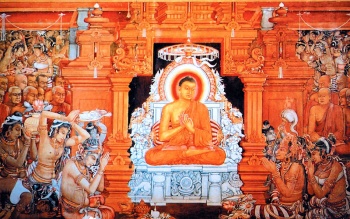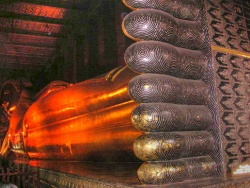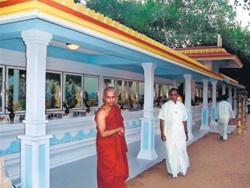Difference between revisions of "Bak Poya: The day Buddha set foot in Lanka for the second time"
| Line 1: | Line 1: | ||
| − | The significance of [[Bak poya]] is historical, since it marks [[Buddha’s]] secondvisit to [[Sri Lanka]]. This is noteworthy, as Bak is a month of | + | The significance of [[Bak poya]] is historical, since it marks [[Buddha’s]] secondvisit to [[Sri Lanka]]. This is noteworthy, as Bak is a month of national importance as well. |
[[File:Duruthu3.jpg|thumb|350px|]] | [[File:Duruthu3.jpg|thumb|350px|]] | ||
According to [[Mahavamsa]], [[Buddha]] could foresee an imminent [[war]] between twoNaga Kings Culodara and Mahodara, uncle and nephew, over a jewel-studded thronethat made Him think of visiting Lanka for the second [[time]]. Professor WilhelmGeiger explains the conflict in the translation of [[Mahavamsa]]: | According to [[Mahavamsa]], [[Buddha]] could foresee an imminent [[war]] between twoNaga Kings Culodara and Mahodara, uncle and nephew, over a jewel-studded thronethat made Him think of visiting Lanka for the second [[time]]. Professor WilhelmGeiger explains the conflict in the translation of [[Mahavamsa]]: | ||
==Mahavamsa== | ==Mahavamsa== | ||
| − | “That same [[ | + | “That same [[Nag] Mahodara]] was then a {{Wiki|King}}, gifted with miraculous [[power]] in a [[Naga]] {{Wiki|Kingdom}} in the ocean, that covered half a thousand [[Yojanas]]. His younger sister had been given (in [[marriage]]) to the [[Naga]]-{{Wiki|King}} on the [[Kannavaddhamana]] mountain; her son was Culodara. His mother’s father had given to his mother asplendid throne of jewels, then the [[Naga]] had [[died]] and therefore this [[war]] ofnephew with uncle was threatening and also the [[Nagas]] of the mountains were armedwith miraculous [[power]]. |
[[Mahavamsa]] also records that [[the Buddha]] was accompanied by a [[deity]] to SriLanka. | [[Mahavamsa]] also records that [[the Buddha]] was accompanied by a [[deity]] to SriLanka. | ||
| − | “The [[deva]] named Samiddhisumana took a rajayatana-tree standing in Jetavana,his own fair habitation and [[holding]] it like a [[parasol]] over the conqueror, hewith the Teacher’s leave, attended him to that spot where he had formerlydwelt. That very [[deva]] had been, in his latest [[birth]], a man in Nagadipa. | + | “The [[deva]] named [[Samiddhisumana]] took a rajayatana-tree standing in [[Jetavana]],his own fair habitation and [[holding]] it like a [[parasol]] over the conqueror, hewith the Teacher’s leave, attended him to that spot where he had formerlydwelt. That very [[deva]] had been, in his latest [[birth]], a man in Nagadipa. |
| − | On the spot where thereafter the rajayatana-tree stood, he | + | On the spot where thereafter the rajayatana-tree stood, he saw [[paccekabuddhas]] taking their meal. And at the [[sight]] his [[heart]] was [[glad]] and he offered branches to cleanse the [[alms-bowl]]. |
| − | Therefore he was [[reborn]] in that [[tree]] in the [[pleasant]] Jetavans garden, and it(the [[tree]]) stood afterwards outside at the side of the gate-rampart. The [[God]] | + | Therefore he was [[reborn]] in that [[tree]] in the [[pleasant]] [[Jetavans]] garden, and it(the [[tree]]) stood afterwards outside at the side of the gate-rampart. The [[God]] of all [[gods]] saw (in this) an advantage for that [[deva]] and for the sake of the good which should spring (therefrom) for our land, he brought him hither (to Lanka)together with his [[tree]]. |
| − | [[Mahavamsa]] then relates how [[Buddha]] settled the dispute and the | + | [[Mahavamsa]] then relates how [[Buddha]] settled the dispute and the next development of events. |
[[File:PICT0044.jpg|thumb|250px|]] | [[File:PICT0044.jpg|thumb|250px|]] | ||
| − | “Hovering there in mid-air above battlefield the [[Master]], who drives away(spiritual) darkness, called forth dread darkness over the [[Nagas]]. | + | “Hovering there in mid-air above battlefield the [[Master]], who drives away(spiritual) darkness, called forth dread darkness over the [[Nagas]]. Then comforting those who were distressed by terror he once again spread light abroad. |
When they saw the [[Blessed One]] they joyfully did reverence to the Master’sfeet. Then preached the Vanquisher to them the [[doctrine]] that begets concord andboth ([[Nagas]]) gladly gave up the throne to the Sage. | When they saw the [[Blessed One]] they joyfully did reverence to the Master’sfeet. Then preached the Vanquisher to them the [[doctrine]] that begets concord andboth ([[Nagas]]) gladly gave up the throne to the Sage. | ||
| Line 22: | Line 22: | ||
“When the [[Master]], having alighted on the [[earth]], had taken his place on aseat there and had been refreshed with celestial [[food]] and drink by theNaga-Kings, he the [[Lord]], established in the (three) [[refuges]] and in the moralprecepts eighty kotis of snake-spirits, dwellers in the ocean and on themainland. | “When the [[Master]], having alighted on the [[earth]], had taken his place on aseat there and had been refreshed with celestial [[food]] and drink by theNaga-Kings, he the [[Lord]], established in the (three) [[refuges]] and in the moralprecepts eighty kotis of snake-spirits, dwellers in the ocean and on themainland. | ||
| − | “The Naga-King Maniakkhika of Kalyani mother’s brother to the [[Naga]] Mahodara,who had come thither to take part in the battle and who, | + | “The Naga-King Maniakkhika of Kalyani mother’s brother to the [[Naga]] Mahodara,who had come thither to take part in the battle and who, a foretime, at theBuddha’s first coming, having heard the true [[doctrine]] preached, had becomeestablished in the [[refuges]] and the [[moral]] duties, prayed now to the Tathagata:‘Great is the [[compassion]] that thou hast [you have] shown us here, O [[Master]]! |
[[File:Pls16.jpg|thumb|250px|]] | [[File:Pls16.jpg|thumb|250px|]] | ||
Hadst thou [had you] not appeared we had all been consumed to ashes. May thy[your] [[compassion]] yet [[light]] also especially on me, O thou who art [are] rich inloving-kindness, in that thou shalt [shall] come again hither to my dwellingcountry, O thou peerless one’. | Hadst thou [had you] not appeared we had all been consumed to ashes. May thy[your] [[compassion]] yet [[light]] also especially on me, O thou who art [are] rich inloving-kindness, in that thou shalt [shall] come again hither to my dwellingcountry, O thou peerless one’. | ||
| Line 33: | Line 33: | ||
[[Buddha’s]] visits to [[Sri Lanka]] are believed to be false and legendary incertain sects. One [[reason]] is that it is not contained in Thripitaka, theofficial document of [[Buddha’s]] [[life]]. Thripitaka contains more of philosophicallyimportant factors, rather than history. [[Buddha]] had been to [[Sri Lanka]] thrice:first visit to Mahiyangana, second to Jaffna, then called as Nagadipa, andthird to Kelaniya. | [[Buddha’s]] visits to [[Sri Lanka]] are believed to be false and legendary incertain sects. One [[reason]] is that it is not contained in Thripitaka, theofficial document of [[Buddha’s]] [[life]]. Thripitaka contains more of philosophicallyimportant factors, rather than history. [[Buddha]] had been to [[Sri Lanka]] thrice:first visit to Mahiyangana, second to Jaffna, then called as Nagadipa, andthird to Kelaniya. | ||
| − | The common question is that if [[Buddha]] had already been to [[Sri Lanka]], notonly once, but thrice, why did [[Arahant]] [[Mahinda]] visit [[Sri Lanka]] once again.Arahant [[Mahinda]], of course, had a mission to fulfil: to establish | + | The common question is that if [[Buddha]] had already been to [[Sri Lanka]], notonly once, but thrice, why did [[Arahant]] [[Mahinda]] visit [[Sri Lanka]] once again.Arahant [[Mahinda]], of course, had a mission to fulfil: to establish the Upasampada [[Bhikku]] [[order]]. The suitable [[time]] was not ripe for [[Buddha]] to consider establishing the serious [[Bhikku]] [[order]]. However [[Buddhism]] was not alien when Arahant [[Mahinda]] set foot. |
{{R}}http://www.lakehouse.lk/mihintalava/buddha03.htm | {{R}}http://www.lakehouse.lk/mihintalava/buddha03.htm | ||
[[Category:Theravada Buddhism]] | [[Category:Theravada Buddhism]] | ||
Revision as of 15:23, 26 August 2013
The significance of Bak poya is historical, since it marks Buddha’s secondvisit to Sri Lanka. This is noteworthy, as Bak is a month of national importance as well.
According to Mahavamsa, Buddha could foresee an imminent war between twoNaga Kings Culodara and Mahodara, uncle and nephew, over a jewel-studded thronethat made Him think of visiting Lanka for the second time. Professor WilhelmGeiger explains the conflict in the translation of Mahavamsa:
Mahavamsa
“That same [[Nag] Mahodara]] was then a King, gifted with miraculous power in a Naga Kingdom in the ocean, that covered half a thousand Yojanas. His younger sister had been given (in marriage) to the Naga-King on the Kannavaddhamana mountain; her son was Culodara. His mother’s father had given to his mother asplendid throne of jewels, then the Naga had died and therefore this war ofnephew with uncle was threatening and also the Nagas of the mountains were armedwith miraculous power. Mahavamsa also records that the Buddha was accompanied by a deity to SriLanka.
“The deva named Samiddhisumana took a rajayatana-tree standing in Jetavana,his own fair habitation and holding it like a parasol over the conqueror, hewith the Teacher’s leave, attended him to that spot where he had formerlydwelt. That very deva had been, in his latest birth, a man in Nagadipa.
On the spot where thereafter the rajayatana-tree stood, he saw paccekabuddhas taking their meal. And at the sight his heart was glad and he offered branches to cleanse the alms-bowl.
Therefore he was reborn in that tree in the pleasant Jetavans garden, and it(the tree) stood afterwards outside at the side of the gate-rampart. The God of all gods saw (in this) an advantage for that deva and for the sake of the good which should spring (therefrom) for our land, he brought him hither (to Lanka)together with his tree.
Mahavamsa then relates how Buddha settled the dispute and the next development of events.
“Hovering there in mid-air above battlefield the Master, who drives away(spiritual) darkness, called forth dread darkness over the Nagas. Then comforting those who were distressed by terror he once again spread light abroad.
When they saw the Blessed One they joyfully did reverence to the Master’sfeet. Then preached the Vanquisher to them the doctrine that begets concord andboth (Nagas) gladly gave up the throne to the Sage.
“When the Master, having alighted on the earth, had taken his place on aseat there and had been refreshed with celestial food and drink by theNaga-Kings, he the Lord, established in the (three) refuges and in the moralprecepts eighty kotis of snake-spirits, dwellers in the ocean and on themainland.
“The Naga-King Maniakkhika of Kalyani mother’s brother to the Naga Mahodara,who had come thither to take part in the battle and who, a foretime, at theBuddha’s first coming, having heard the true doctrine preached, had becomeestablished in the refuges and the moral duties, prayed now to the Tathagata:‘Great is the compassion that thou hast [you have] shown us here, O Master!
Hadst thou [had you] not appeared we had all been consumed to ashes. May thy[your] compassion yet light also especially on me, O thou who art [are] rich inloving-kindness, in that thou shalt [shall] come again hither to my dwellingcountry, O thou peerless one’.
When the Buddha had consented by his silence to come thither [there], heplanted the rajayatana-tree on that very spot as a sacred memorial and the Lordof the Worlds gave over the rajayatana-tree and the precious throne-seat to theNaga-Kings to do homage thereto. ‘In remembrance that I have used these dohomage to them, ye Naga-Kings!”
Buddha’s calling forth dread darkness over the Nagas should not bemisunderstood. The Buddha holds fame for being the Greatest Compassionate onearth. The concept bears a symbolic meaning; Buddha preached the dark side ofthe world, and the Naga tribes were scared just to hear and visualise them.That paved the way for them to a comfort later on.
Visits
Buddha’s visits to Sri Lanka are believed to be false and legendary incertain sects. One reason is that it is not contained in Thripitaka, theofficial document of Buddha’s life. Thripitaka contains more of philosophicallyimportant factors, rather than history. Buddha had been to Sri Lanka thrice:first visit to Mahiyangana, second to Jaffna, then called as Nagadipa, andthird to Kelaniya.
The common question is that if Buddha had already been to Sri Lanka, notonly once, but thrice, why did Arahant Mahinda visit Sri Lanka once again.Arahant Mahinda, of course, had a mission to fulfil: to establish the Upasampada Bhikku order. The suitable time was not ripe for Buddha to consider establishing the serious Bhikku order. However Buddhism was not alien when Arahant Mahinda set foot.


